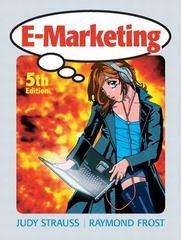Question
Summing up last month's column Last month, I askedwhat we could do to sustain organization diversityand whether we err in first hiring a more diverse
Summing up last month's column
Last month, I askedwhat we could do to sustain organization diversityand whether we err in first hiring a more diverse workforce, perhaps to meet a goal, before working on skills to ensure that new hires feel included in decisions and execution. Respondents conveyed the sense that the challenge is substantial. They suggested, among other things, that organizations need to change their value structure, training, hiring, and measurement.
Danny commented that "Diversity and inclusion must be clearly spelled out in the PURPOSE of the organization ... our core values must speak to D&I."
Steve Hopkins added, "I am encouraged by (the) mention of attitude. I would suggest one verb further; behavior ... Results are not realized in how an organization thinks or feels about diversity (or any other value). It is how it behaves."
Meena R. provided a practical example: "When we think of diversity, we bring in people to improve diversity and then expect them to fit into existing systems and structures ... For instance, if I were to take the example of India, often meetings start at 4 p.m. and go on till 7 p.m. If the organization is serious about having more women, ensure that meetings are held in the morning ... Organizations don't want to changethey want the individuals to 'adjust.' And then they call it diversity and inclusion!"
Turning to training, Donna K. remarked that "Equity and inclusion are continuous processes. Inclusion and equity practices must involve initially educating the senior leaders, as these are the folks who can open the right doors, ... make the needed resources available, and align the D&I process with all of the business objectives. Additionally, leadership must be prepared to model inclusive behavior to set the tone throughout the rest of the organization."Summing up last month's column
Last month, I askedwhat we could do to sustain organization diversityand whether we err in first hiring a more diverse workforce, perhaps to meet a goal, before working on skills to ensure that new hires feel included in decisions and execution. Respondents conveyed the sense that the challenge is substantial. They suggested, among other things, that organizations need to change their value structure, training, hiring, and measurement.
Danny commented that "Diversity and inclusion must be clearly spelled out in the PURPOSE of the organization ... our core values must speak to D&I."
Steve Hopkins added, "I am encouraged by (the) mention of attitude. I would suggest one verb further; behavior ... Results are not realized in how an organization thinks or feels about diversity (or any other value). It is how it behaves."
Meena R. provided a practical example: "When we think of diversity, we bring in people to improve diversity and then expect them to fit into existing systems and structures ... For instance, if I were to take the example of India, often meetings start at 4 p.m. and go on till 7 p.m. If the organization is serious about having more women, ensure that meetings are held in the morning ... Organizations don't want to changethey want the individuals to 'adjust.' And then they call it diversity and inclusion!"
Turning to training, Donna K. remarked that "Equity and inclusion are continuous processes. Inclusion and equity practices must involve initially educating the senior leaders, as these are the folks who can open the right doors, ... make the needed resources available, and align the D&I process with all of the business objectives. Additionally, leadership must be prepared to model inclusive behavior to set the tone throughout the rest of the organization."
DISCUSS YOUR ANSWERS CAREFULLY
Question four.
1. Many economist who was known to be the founders of the economics theories describe several techniques like supply of goods meaning that
2. What organize you unkind by 'under conditions of a perfect struggle in the product market'__________?
3. Which of the next is the family member that the law of demand expresses_________?
4. Moreover, a economist anylized the basic factors which affect the economy he factor out the mixed economy to be?
5. What prepare you nasty by the petition of a article of trade?
6. Starting from the time of independence, why did India follow a planned economy?
1.India followed a five-year plan and required an outlook.
2.Directive Principles of Indian Constitutionindicated the planned vision of India.
3.There was no indication whatsoever from the five year plans regarding how much of each and every good and service is to be produced.
Choose the correct statements from the given options
7. What see to you uncaring by Unsophisticated National Merchandise?
8. Which of the following is the reason for the decline in the child sexual practice ratio in India?
9. What influences are taken into contemplation while revising the poverty line every so often?
10. In India, which banks/institutes have the highest share in the expenditure of acknowledgement to gardening and connected happenings?
Step by Step Solution
There are 3 Steps involved in it
Step: 1

Get Instant Access to Expert-Tailored Solutions
See step-by-step solutions with expert insights and AI powered tools for academic success
Step: 2

Step: 3

Ace Your Homework with AI
Get the answers you need in no time with our AI-driven, step-by-step assistance
Get Started


